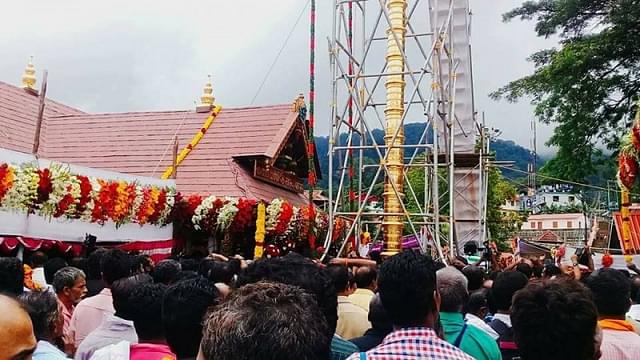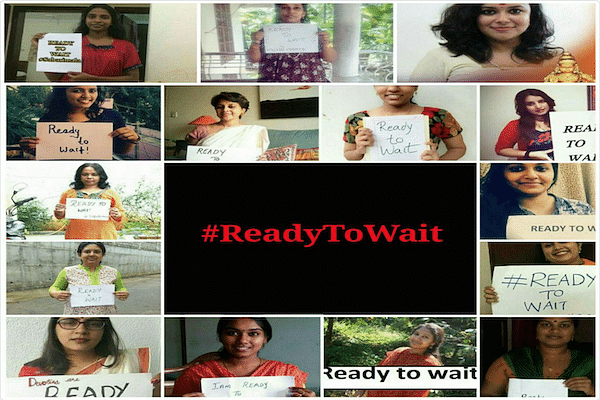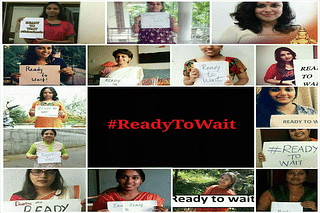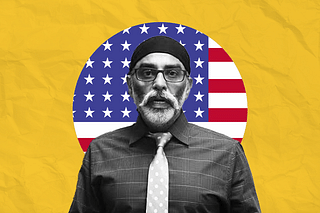Ideas
Explained: #RightToPray Versus #ReadyToWait
Binoy Ashokan Chalakkudy
Oct 16, 2017, 03:14 PM | Updated 03:14 PM IST
Save & read from anywhere!
Bookmark stories for easy access on any device or the Swarajya app.

With the Supreme Court referring the issue of women's entry into Sabarimala to a constitutional bench on 13 October, the issue is back in the news now.
It is the five south Indian states, from which the majority of Sabarimala devotees come. For the same reason, the rest of India may not be well informed about this issue beyond what national media discusses regarding the simple narrative of gender equality. For their benefit, here is what this case is all about. The two sides, who are contesting against each other, in this case can be broadly categorised under two hashtags – #RightToPray and #ReadyToWait.
First, let us briefly look at what both sides stand for. #RightToPray is supposed to be a gender equality movement that draws its pride from their perceived victory at Haji Ali Dargah and Shani Shingnapur temple last year where women were allowed entry to offer prayers.
The other side, #ReadyToWait, is declaring itself to be a movement created by the women devotees of Lord Ayyappa, the deity of the hill shrine Sabarimala. Their aim, in simple terms, seems to be telling us that Sabarimala women entry issue is not a gender equality matter as its new champions would want to project it as.
As the #RightToPray concept is of less ambiguity, let us try to understand more about the novel idea of #ReadyToWait.
To begin with, it should be understood that the usage of the phrase ‘ban on women entry’ is totally wrong for Sabarimala, unlike in the case of Shani Shinganpure temple or Haji Ali Dargah, where it was a blanket ban on women entering the particular pray areas of those shrines, which was started very recently in the case of Haji Ali, supposed to be only after 2011.
Every year lakhs of women visit and pray at Sabarimala. So let us first be clear on this point that there is no ban on women in Sabarimala.
But, there is indeed a restriction on women belonging to a particular age group – 10 to 50 years – to be more precise. This custom is followed by women devotees of Lord Ayyappa by their own choice from time immemorial. There was neither any strict imposing of this practice nor any monitoring by any authority. It was only in 1991 there came a formal imposing of this restriction with a high court order followed by the petition of a (male) devotee complaining about some VIPs were given exemption to come to Sabarimala contrary to the customs followed in the temple.
Now let us analyse the premises of this tradition of Sabarimala.
In Sabarimala, Lord Ayyappa is being worshiped in the form of a celibate (brahmachari). The pujas, rituals, traditions and everything related to Sabarimala are designed in accordance with this special posture of its celibate deity. Devotees have to observe strict vrata (brahmacharya vratha) of up to 41 days including maintaining physical purity, abstaining from earthly pleasures like consumption of alcohol, meat or indulging in sexual activities etc, as part of the preparation for their yearly pilgrimage to Sabarimala.
The main argument on why women of a particular age group were not welcome in Sabarimala comes from the folklores of Lord Ayyappa which we can see that towards the end of his life as a man he chose to be a celibate and wanted to become part of the murthi or deity of the temple, which was constructed by the king of Panthalam, Lord Ayyappa’s adoptive father, on the instruction of the lord himself. He had chosen the steep mountains in the deep forest as his abode for his eternal yogic sleep so that he can stay away, as much as possible, from the worldly affairs.
It is in the culture of our land, as part of Sanatana Dharama that nobody wants to disturb such a yogi by their presence. This also explains why Sabarimala is not open for darshan throughout the year. Young women prefer to stay away from such celibate yogis out of respect.


One of the main arguments seems to have been raised by #ReadyToWait camp and its supporters is that the celibate posture of Lord Ayyappa is what mandates the pre-conditions, which is the strict vrata, for his devotees to come and worship him once in a year so as to have very minimal disturbance to his permanent yogic posture. So they are asking, if somebody is not believing in these pre-conditions as part of the Sabarimala pilgrimage, then it means that he or she doesn’t believe in Lord Ayyappa. If he or she doesn’t believe in Sabarimala’s Lord Ayyappa in its current form, then why should he or she insist on going there?
It indicates that their insistence does not stem from devotion. They are free to go to hundreds of other Ayyappa temples across the country, where the deity’s posture is not that of a celibate, and hence there are no restrictions of any kind. The revolting, non-believing, Ayyappa fans (yes, not devotees) can very well visit any of those temples and offer their prayers (if any). The problems should disappear there itself.
What those who are in revolting gear don’t understand is that the rituals and customs are different in all temples. One temple may have a celibate Ayyappa and in another we may have a bala (infant) Ayyappa. And both can have considerable difference in their rituals. That is the way of Hindu worship. You cannot compare it with one-book-one-god Semitic religions. One cannot impose a change to a temple just because one doesn’t like it. If such rituals and customs are not causing any harm to public life then there is no provision for any attempt to curb it by force by any secular establishments – be it an elected government or a court of law.
Before branding Kerala and its Hindus as anti-women, one should take note that there are women-only temple rituals in the state, where no man is allowed during its rituals and celebrations. One such big Kerala temple is the Attukal Devi Temple, which is also known as women’s Sabarimala. This temple has found a place in Guinness World Records for the sheer number of women gathering on a single day. Nobody considers it as a violation of gender equality against men under Article 14 of the Indian Constitution. Every sane person understands that it is the ritual of one particular temple and they recognise it. It is the same case in Sabarimala, which is just another temple, where you have a different set of rituals, the rituals which give the Sabarimala its unique position in the Hindu way of life in India.
Those who are eager to brand Sabarimala as a regressive Hindu icon with half-baked information should understand one more important fact that Sabarimala is one of the very few prominent temples in India where there is no restriction in the name of caste or religion. Be it a Muslim or a Christian or those practising any other religion, can go to Sabarimala if they follow the rituals. The only precondition for entering the temple is that one should be ready to follow the rituals and customs.
It is important to point out that there is a mosque at the foothills of Sabarimala, which is believed to be belonging to Lord Ayyappa’s friend, who was a Muslim. Devotees call him Vavar swami. It is mandatory for all Ayyappa devotees to visit this mosque first before they start climbing the hill towards Sabarimala. This is also a part of the ritual. You cannot find it in the Constitution of India.
These special traditions and rituals make Sabariamala what it is today. Without all these, Sabarimala will be just one of the hundreds or thousands of other temples. So before one raises his/her sword against Sabarimala in the name of gender equality he/she should understand that Sabarimala is the epitome of equality in all aspects, be it caste, religion or gender.
Those who are entering this debate must understand first and foremost that temples of Hindus are not run by the Constitution. It is meant only for those who believe in it. And until the rituals based on belief don’t affect the civil health of the society, nobody has any right to alter it. Hindus of this country have done it in the past and I hope that they will do it in future also whenever the need of a reform arises. Even in this issue also they are capable of differentiating between the rights and wrongs.
Also read: Sacred Sabarimala: ‘Right To Destroy A Tradition’ Versus ‘Ready To Wait’
Save & read from anywhere!
Bookmark stories for easy access on any device or the Swarajya app.
Introducing ElectionsHQ + 50 Ground Reports Project
The 2024 elections might seem easy to guess, but there are some important questions that shouldn't be missed.
Do freebies still sway voters? Do people prioritise infrastructure when voting? How will Punjab vote?
The answers to these questions provide great insights into where we, as a country, are headed in the years to come.
Swarajya is starting a project with an aim to do 50 solid ground stories and a smart commentary service on WhatsApp, a one-of-a-kind. We'd love your support during this election season.
Click below to contribute.





